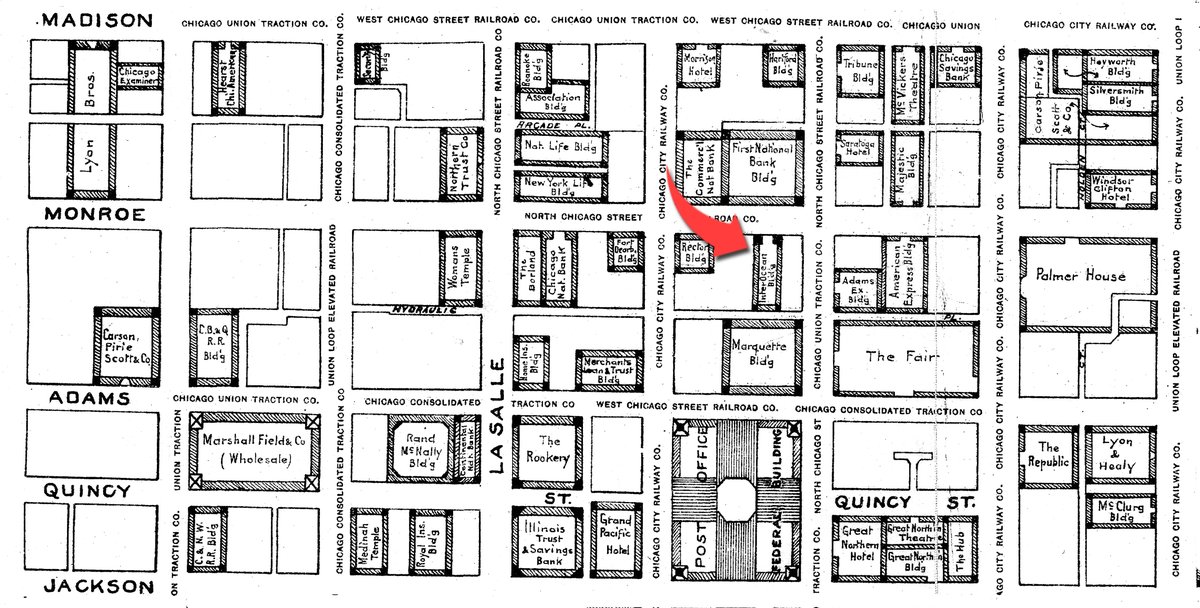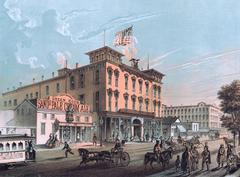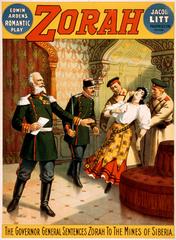
McVicker’s Theater Chicago: Visiting Hours, Tickets, and Historical Significance
Date: 15/06/2025
Introduction
Located in the heart of Chicago’s historic Loop district, McVicker’s Theater was once a defining pillar of the city’s cultural and theatrical landscape. Founded in 1857 by James H. McVicker, this iconic venue was instrumental in elevating Chicago’s artistic reputation, hosting legendary performers and pioneering entertainment innovations for over a century. Although the original theater was demolished in 1985, its enduring legacy can be experienced today through the historic site at 25 W. Madison Street, nearby architectural landmarks, and a wealth of digital archives. This guide details McVicker’s Theater’s fascinating history, its ongoing influence, and practical information for visitors eager to explore Chicago’s theatrical heritage.
Table of Contents
- Why Visit McVicker’s Theater?
- Historical Overview
- Visiting Today: Location, Hours, and Tours
- Nearby Attractions
- Accessibility and Visitor Services
- Planning Tips
- Frequently Asked Questions
- Architectural Significance
- Conclusion
- References and Useful Links
Why Visit McVicker’s Theater?
While the original McVicker’s Theater no longer stands, its former site and the surrounding Loop district remain a living showcase of Chicago’s cultural evolution. Visiting the location at 25 W. Madison Street offers a gateway to the city’s storied performing arts legacy, complemented by nearby historic venues such as the Chicago Theatre and the Auditorium Theatre. Whether you are a history enthusiast, architecture admirer, or theater lover, exploring McVicker’s legacy provides a rich context for understanding Chicago’s rise as an arts capital (Chicagology.com, Chicago Theatre Info, Chicago Public Library Digital Collection).
Historical Overview
Founding and Early Years (1857–1871)
James H. McVicker, a prominent actor and theater manager, established McVicker’s Theater in 1857 at 25 W. Madison Street with an investment of $85,000. The venue quickly gained a reputation for excellence, drawing celebrated performers such as Edwin Booth, who debuted in 1858, and presenting high-quality productions that set new standards for Chicago’s cultural scene (chicagology.com).
Rebuilding After the Great Chicago Fire (1871–1922)
The devastating Great Chicago Fire of 1871 destroyed the original building, but McVicker’s was among the first theaters to be rebuilt, symbolizing the city’s resilience. Over the following decades, the theater endured several fires and was reconstructed each time, reflecting both the owners’ determination and the city’s robust demand for live entertainment. McVicker’s hosted landmark productions, including the nation’s first musical comedy, “The Black Crook,” in a record-breaking run (chicagology.com).
International stars like Sarah Bernhardt also headlined at McVicker’s, cementing its reputation as a world-class venue.
The 1922 Reconstruction and the Roaring Twenties
In 1922, the theater underwent a significant redesign by architects Henry L. Newhouse and F. M. Burnham, featuring a Greek-inspired facade and seating for nearly 2,000 patrons. This era saw the introduction of Chicago’s first talking motion picture, live orchestral stage shows, and other technological advancements, keeping McVicker’s at the forefront of entertainment innovation (chicagology.com).
Mid-20th Century Innovations
During the 1930s and beyond, McVicker’s adapted to changing tastes, celebrating milestones such as its 80th anniversary with notable film screenings and introducing new cinematic technologies like the Todd AO process. Briefly returning to live stage productions in the 1960s, the theater ultimately focused on film presentations, including Cinerama features and Hollywood epics (chicagology.com).
Notable Performers and Cultural Impact
McVicker’s Theater was a stage for some of the greatest names in theater, including James H. McVicker, Edwin Booth, Sarah Bernhardt, John Barrymore, and Michael Todd. Its programming reflected and influenced Chicago’s social, cultural, and artistic currents, evolving from Shakespearean drama and opera to vaudeville, musical comedies, and cinematic presentations (chicagology.com).
Decline and Demolition (1970s–1985)
Facing competition from multiplexes and shifting entertainment preferences, McVicker’s struggled in its final years. By the early 1980s, declining attendance and structural concerns led to its closure and eventual demolition in 1985, ending a chapter but not the legacy of Chicago’s theatrical history (chicagology.com).
Visiting Today: Location, Hours, and Tours
- Address: 25 W. Madison Street, between State and Dearborn, Chicago, IL
- Current Status: The original theater is no longer standing, but the site is part of Chicago’s historic theater district and is accessible for self-guided exploration.
- Visiting Hours: Public sidewalks allow access to the site at all times. There are no specific hours or tickets required for the former McVicker’s Theater itself.
- Tours: Many local tour providers include the McVicker’s site in their guided walking tours of the Loop’s historic theaters and architecture.
For tickets to performances at nearby venues such as the Chicago Theatre or Auditorium Theatre, visit Theatre In Chicago or the official theater websites.
Nearby Attractions
- Chicago Theatre: Tours and live performances; a must-see for theater fans (Chicago Theatre Info).
- Auditorium Theatre: Designed by Adler & Sullivan, offering architectural tours and events (Auditorium Theatre Official Site).
- Art Institute of Chicago: Renowned art collections and exhibitions.
- Millennium Park: Public art, gardens, and concerts.
- Chicago Cultural Center: Free exhibits and architectural highlights (Chicago Cultural Center).
For more suggestions, see Choose Chicago – Theatre Recommendations.
Accessibility and Visitor Services
- Accessibility: The area is wheelchair accessible, and nearby theaters offer accessible seating, restrooms, and assistive listening devices. Contact individual venues in advance to arrange accommodations.
- Transportation: The Loop is easily reached via CTA Red and Blue Line trains (Monroe or Washington stops) and numerous bus routes. Public parking is available nearby.
- Dining: The Loop offers a variety of dining options, from casual food halls to upscale restaurants. Reservations are recommended during peak times.
- Safety: The downtown area is generally safe, with active security measures at theaters and public spaces.
Planning Tips
- Book Tickets Early: For current performances at nearby theaters, check Theatre In Chicago and Chicago Theater Schedule.
- Arrive Early: Plan extra time for parking, transportation, and seating.
- Dress Code: Business casual is common; some may dress up for premieres.
- Photography: Allowed around the district, but restricted inside most theaters.
- Weather: Be prepared for Chicago’s variable climate, especially if walking between venues (The Savvy Globetrotter – Things to Do in Chicago in June).
Frequently Asked Questions
Q: Can I visit McVicker’s Theater today?
A: The original building was demolished in 1985, but you can visit the historic site at 25 W. Madison Street and explore nearby theaters.
Q: Are there tickets available for McVicker’s Theater?
A: No, but tickets for performances at nearby historic venues are available online.
Q: Are guided tours available?
A: Yes, many walking tours of the Loop include the McVicker’s Theater site.
Q: Is the area wheelchair accessible?
A: Yes, the public sidewalks and nearby venues are accessible.
Q: Where can I find historic photos and information?
A: Explore digital archives like Chicagology.com, the Chicago Public Library Digital Collection, and the Encyclopedia of Chicago.
Architectural Significance
McVicker’s Theater was a showcase of evolving theater architecture:
- Original Structure (1857–1871): Designed by Boyington & Wheelock, featuring advanced audience comfort and sightlines.
- Reconstruction After the Great Chicago Fire: Emphasized fireproof construction and safety.
- Adler & Sullivan’s Renovations (1883–1891): Introduced innovative acoustics and organic ornamentation, influencing future theater design (Architecture.org on Adler & Sullivan).
- Final Iteration (1922): Reflected contemporary tastes and integrated technological advancements such as sound and projection systems.
Key features included audience-centric design, superior acoustics, and the adoption of fireproofing technologies, establishing new standards nationally.
Conclusion
McVicker’s Theater stands as a powerful symbol of Chicago’s artistic ambition, resilience, and commitment to cultural innovation. Though the original structure is gone, its spirit endures in the city’s celebrated theater district, nearby historic venues, and the digital archives preserving its story. By exploring the site, attending performances, and delving into the history of neighboring landmarks, visitors can experience the enduring legacy of Chicago’s performing arts scene.
For more in-depth exploration, download the Audiala app for interactive tours, event updates, and insider guides to Chicago’s historic theaters. Follow us on social media for more stories celebrating the city’s architectural and theatrical treasures.
References and Useful Links
- Chicagology.com
- Chicago Theatre Info
- Chicago Public Library Digital Collection
- Theatre In Chicago
- Auditorium Theatre
- Chicago Architecture River Cruise
- Choose Chicago – Theatre Recommendations
- Chicago Theater Schedule
- Encyclopedia of Chicago
- Architecture.org on Adler & Sullivan






























































































































































